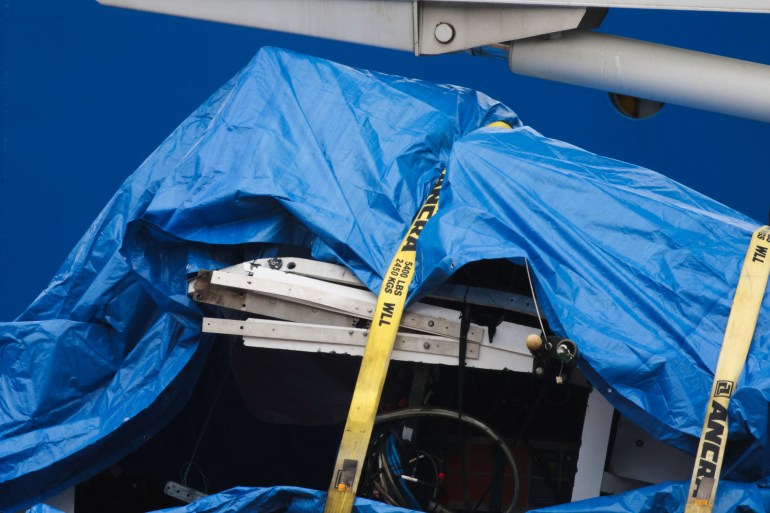Debris, human remains from imploded Titanic sub return to port
Debris and possible human remains from the submersible that imploded on a visit to the Titanic has been hauled back to shore, as authorities investigate what led to the deadly deep-sea disaster.
Members of the United States Coast Guard announced on Wednesday that recovery teams have retrieved what appear to be remains from the five passengers who died on board the Titan submersible.
“United States medical professionals will conduct a formal analysis of presumed human remains that have been carefully recovered within the wreckage at the site of the incident,” the Coast Guard said in a press release.
Earlier in the day, the wreckage of the Titan was returned to the Canadian port city of St John’s, Newfoundland, approximately 600km (375 miles) northwest of the Titanic’s resting place on the ocean floor.
Photos showed what appeared to be the submersible’s nose cone being lowered by a crane onto the docks, as well as tangled wires and white panels from the 6.7-metre (22-foot) vessel.
“Our team has successfully completed off-shore operations,” Pelagic Research Services, a marine research company, said in a statement.
“They have been working around the clock now for ten days, through the physical and mental challenges of this operation, and are anxious to finish the mission and return to their loved ones.”
The Titan lost contact with the surface on June 18, nearly two hours into its descent towards the world’s most famous shipwreck. An international search-and-rescue effort brought about 10 ships to the remote site, some taking days to get there.
US coast guard ship sycamore now in St. John’s harbour along with Horizon Arctic, which arrived earlier this morning pic.twitter.com/0d2Y8dYvXH
— Heather Gillis (@HeatherMGillis) June 28, 2023
Pelagic provided a remotely operated vehicle (ROV), the Odysseus 6K, that combed the ocean floor at the site about 3.8km (2.4 miles) below the surface.
Five passengers were on board the Titan: billionaire Hamish Harding, Titanic researcher Paul-Henri Nargeolet, businessman Shahzada Dawood, his son Suleman Dawood and Stockton Rush, CEO of OceanGate Expeditions, the company that owned the Titan.
After a nearly four-day-long international search effort, the US Coast Guard announced that the Titan had likely suffered a “catastrophic implosion” on the day of its disappearance.
All five passengers are presumed dead. Coast Guard Rear-Admiral John Mauger told reporters that the submersible’s debris had been spotted near the sunken Titanic, about 487m (1,600 feet) from the shipwreck’s bow.
“Odysseus was the subsea asset that located the debris field first referenced by the US Coast Guard,” Pelagic said in a release this past weekend.
Bravo, and welcome back, team! You have made all of us extremely proud of the job you performed flawlessly. Stay safe as you finish up demobilization, and we’ll see you back at base ops. #pelagicresearch #titanrescue pic.twitter.com/uHOAN3ug5W
— Pelagic Research Services (@PelagicResearch) June 28, 2023
Subsequent dives have supported the investigation into what happened in the Titan’s final moments.
“Odysseus’ heavy lift capabilities have been utilized and continue to be utilized in this recovery mission,” Pelagic said on Sunday. A spokesperson for the company, Jeff Mahoney, added that recovery operations “at this depth” are “remarkably difficult and risky”.
Canada’s Transportation Safety Board has worked alongside teams from the United States, France and the United Kingdom, as well as private companies like Pelagic, to recover the remains of the submersible.
A second company, Horizon Maritime, provided the boat — the Horizon Arctic — that towed the Odysseus ROV to waters above the wreckage and brought the pieces back to its home port in St John’s.
The Canadian board has said it plans to conduct a safety investigation into the Titan and its Canadian-flagged cargo vessel, the Polar Prince. The probe will come in three stages: a field phase to collect information, an “examination and analysis” phase, and a final report.
The US Coast Guard will also convene a “marine board of investigation” or MBI. “An MBI is the highest level of investigation in the Coast Guard,” it explained in a release on Sunday.
Safety concerns have been raised in the wake of the Titan disaster, as former passengers have come forward to relay their experiences with communication glitches, thruster issues and other concerns.

Experts have also questioned the use of newer, more experimental materials like carbon fibre to build the submersible, as opposed to better-tested materials such as carbon steel.
According to legal documents first reported by The New Republic magazine, a former engineer with OceanGate, David Lochridge, expressed concern about the submersible’s design and relative lack of high-pressure testing.
OceanGate sued Lochridge for breach of contract related to his comments about the Titan, and Lochridge countersued, claiming the company had attempted to “silence” him. They settled in 2018.




